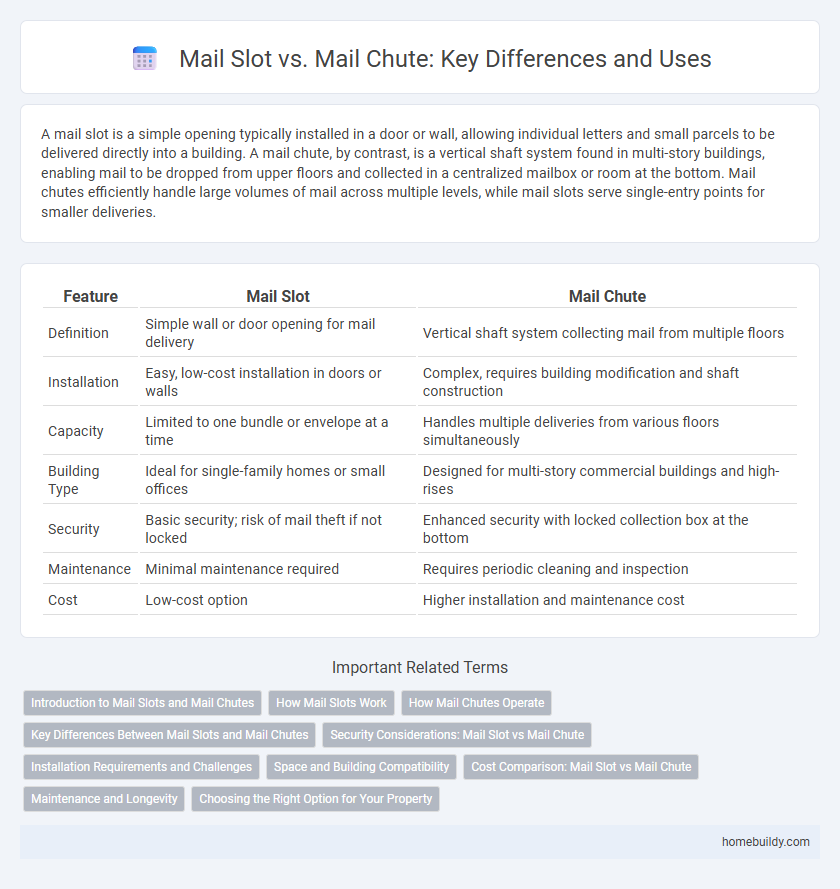A mail slot is a simple opening typically installed in a door or wall, allowing individual letters and small parcels to be delivered directly into a building. A mail chute, by contrast, is a vertical shaft system found in multi-story buildings, enabling mail to be dropped from upper floors and collected in a centralized mailbox or room at the bottom. Mail chutes efficiently handle large volumes of mail across multiple levels, while mail slots serve single-entry points for smaller deliveries.
Table of Comparison
| Feature | Mail Slot | Mail Chute |
|---|---|---|
| Definition | Simple wall or door opening for mail delivery | Vertical shaft system collecting mail from multiple floors |
| Installation | Easy, low-cost installation in doors or walls | Complex, requires building modification and shaft construction |
| Capacity | Limited to one bundle or envelope at a time | Handles multiple deliveries from various floors simultaneously |
| Building Type | Ideal for single-family homes or small offices | Designed for multi-story commercial buildings and high-rises |
| Security | Basic security; risk of mail theft if not locked | Enhanced security with locked collection box at the bottom |
| Maintenance | Minimal maintenance required | Requires periodic cleaning and inspection |
| Cost | Low-cost option | Higher installation and maintenance cost |
Introduction to Mail Slots and Mail Chutes
Mail slots are individual openings installed on doors or walls to allow direct delivery of mail into a building, designed for personal or small-scale use. Mail chutes, on the other hand, are vertical channels typically found in multi-story buildings, enabling mail to be dropped from upper floors to a centralized collection point. Understanding the distinction between mail slots and mail chutes is essential for selecting efficient mail handling solutions in residential versus commercial environments.
How Mail Slots Work
Mail slots function by allowing mail to be inserted directly into a secured slot on a door or wall, where it drops into a collection area inside the building. Unlike mail chutes that rely on gravity to transport mail vertically through a shaft, mail slots offer a direct, individual access point for each delivery. This system enhances security by controlling access to incoming mail and reduces the need for post-delivery sorting within the building.
How Mail Chutes Operate
Mail chutes operate by allowing users to deposit mail on upper floors of a building through vertical slots that lead to a centralized collection box on the ground floor. Unlike mail slots, which are typically installed on individual doors for direct mail delivery, mail chutes collect mail from multiple floors, enhancing efficiency in high-rise buildings. The chute system relies on gravity to transport envelopes and small packages downward swiftly and securely.
Key Differences Between Mail Slots and Mail Chutes
Mail slots are individual openings typically installed on residential doors or walls, allowing mail to be directly deposited into a secure interior compartment, while mail chutes are vertical shafts found in multi-story buildings that collect mail from multiple floors into a centralized collection box. Mail slots offer convenience and privacy for single-unit residences but lack the capacity and scalability of mail chutes, which serve multiple tenants or offices simultaneously. Security, installation complexity, and building type are critical factors distinguishing mail slots from mail chutes in mail handling systems.
Security Considerations: Mail Slot vs Mail Chute
Mail slots offer limited security as they provide direct access to the interior, increasing the risk of mail theft and unauthorized entry. Mail chutes enhance security by funneling mail into a secure, locked collection area, preventing physical tampering. Choosing between the two depends on the need for safe mail handling versus installation simplicity.
Installation Requirements and Challenges
Mail slots require minimal installation, often integrated into existing doors or walls, making them suitable for residential use with straightforward modifications. Mail chutes, designed for multi-story buildings, involve complex installation that requires vertical shafts, precise alignment, and integration with building infrastructure. Challenges for mail chutes include compliance with fire safety codes, regular maintenance to prevent blockages, and higher initial costs compared to mail slots.
Space and Building Compatibility
Mail slots require minimal building modifications and are ideal for spaces with limited floor area, fitting directly into doors or walls without extending beyond the surface. Mail chutes demand vertical shafts through multiple floors, making them suitable for larger commercial buildings with ample space for installation and maintenance. Space constraints and building structure significantly influence the choice between compact mail slots and multi-story mail chutes.
Cost Comparison: Mail Slot vs Mail Chute
Mail slots generally offer a more cost-effective solution compared to mail chutes due to lower installation and maintenance expenses. Mail chutes require complex construction modifications and regular servicing, leading to higher long-term costs. Choosing mail slots reduces upfront investment and minimizes operational expenses, making them ideal for budget-conscious building projects.
Maintenance and Longevity
Mail slots require minimal maintenance due to their simple design, with occasional cleaning to prevent jams and ensure smooth mail delivery. Mail chutes involve more complex components like pulleys and cables, necessitating regular inspections and lubrication to maintain functionality and safety. Proper upkeep of mail chutes extends their longevity but generally demands more effort compared to the low-maintenance nature of mail slots.
Choosing the Right Option for Your Property
Mail slots offer a secure and convenient way to receive mail directly into your property, ideal for residential use with limited space. Mail chutes, commonly found in multi-story commercial buildings, efficiently transport mail to centralized collection points, enhancing operational workflow. Evaluating property size, security needs, and mail volume helps determine the optimal solution between a mail slot and mail chute.
mail slot vs mail chute Infographic

 homebuildy.com
homebuildy.com